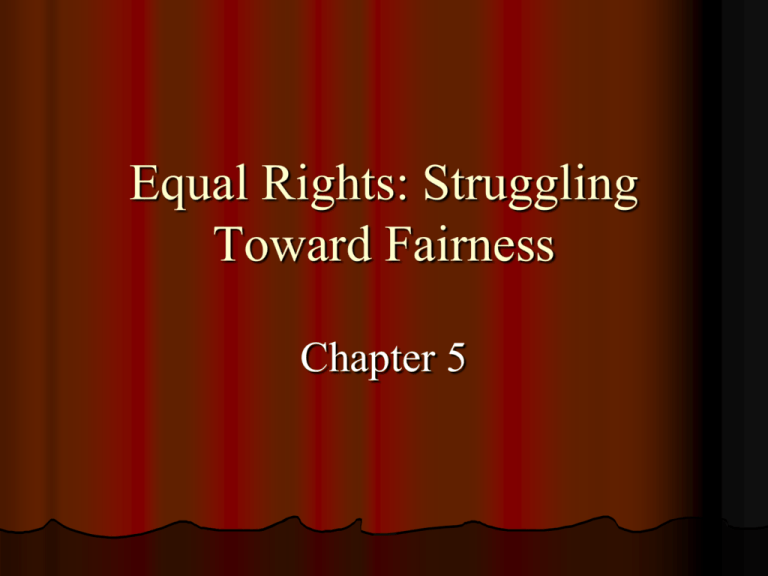
Equal Rights: Struggling
Toward Fairness
Chapter 5
Struggle for Equality
African Americans
Brown
vs. Board of Education of Topeka (1954)
Black civil rights movement
March
on Washington, 1963
Civil Rights Act (1964) and Voting Rights Act (1965)
Aftermath
of the civil rights movement
Discrepancies in
convictions and sentencing
Movement into political office
© 2009 McGraw-Hill Higher Education. All rights reserved.
2
Struggle for Equality
Women
Legal
and political gains
Title VII
of the Civil Rights Act (1964)
Title IX of the Education Amendment (1972)
Job-related
issues
Family
leave
Comparable worth (gender pay equity)
Sexual harassment
© 2009 McGraw-Hill Higher Education. All rights reserved.
3
Struggle for Equality
Native Americans
Suits
to regain land
Negative discrepancy in health, wealth, and
education
Hispanic Americans
Legal
and political action: Cesar Estrada Chavez,
(1927-1993)
Guest workers
Growing political power (Democratic leanings)
© 2009 McGraw-Hill Higher Education. All rights reserved.
4
Struggle for Equality
Asian Americans
Long
tradition of immigration restriction, ended
1965
Over 12 million Asian Americans
Emphasis on academic achievement in Asian
American communities
Upwardly mobile group
© 2009 McGraw-Hill Higher Education. All rights reserved.
5
Struggle for Equality
Other groups and their rights
Older
Americans
Disabled
Gays
Americans
and lesbians
© 2009 McGraw-Hill Higher Education. All rights reserved.
6
Equality Under the Law: the
Fourteenth Amendment
Forbids states from denying equal protection
Strict scrutiny test
Intermediate scrutiny test
Suspect category—assumed unconstitutional in the absence of an
overwhelming justification
Applies to race, ethnicity, etc.
Almost suspect category—assumed unconstitutional unless the law
serves a clearly compelling and justified purpose
Applies to gender
Reasonable basis test
Not suspect category—assumed constitutional unless no sound
rationale for the law can be provided
Applies to age, income, etc.
© 2009 McGraw-Hill Higher Education. All rights reserved.
7
Levels of Court Review for Laws
that Treat Americans Differently
© 2009 McGraw-Hill Higher Education. All rights reserved.
8
Equality Under the Law:
Equal Access
The Civil Rights Acts of 1964 and 1968
Accommodations
and jobs
Public
accommodations cannot refuse to serve
customers based on race
Most employers cannot refuse to consider applicants
based on race
Housing
Prohibition of
redlining
© 2009 McGraw-Hill Higher Education. All rights reserved.
9
Equality Under the Law:
Equal Ballots
Barring of whites-only primaries, 1940s
Twenty-fourth Amendment prohibited poll
taxes, 1960s
Voting Rights Act of 1965 allowed federal
agents to oversee voter registration
Some race-based gerrymandering is allowed
© 2009 McGraw-Hill Higher Education. All rights reserved.
10
What’s Your Opinion?
Should private discrimination be allowed?
Should
private country clubs and organizations be
allowed to discriminate based on:
Religion, race,
color, ethnic background?
Gender, age, income?
Physical characteristics, sexual preference, lifestyles?
© 2009 McGraw-Hill Higher Education. All rights reserved.
11
Equality of Result
De facto discrimination
Social,
economic, cultural biases discrimination
De jure discrimination
Specific
law discrimination
© 2009 McGraw-Hill Higher Education. All rights reserved.
12
Equality of Result
Affirmative action: workplace integration
Full
and equal opportunities in education,
employment, etc. for all
Controversy over ends and means
Affirmative action in law
University
of California Regents v. Bakke (1978)
Adarand v. Pena (1995)
© 2009 McGraw-Hill Higher Education. All rights reserved.
13
What’s Your Opinion?
Which position on affirmative action programs
comes closer to your own point of view?
Keep
them without rigid quotas?
Phase them out?
Don’t know or have an opinion?
© 2009 McGraw-Hill Higher Education. All rights reserved.
14
Equality of Result
School integration
Busing: controversial policy to end de facto
segregation of public schools
Swann v. Charlotte-Mecklenburg County Bd.
of Education (1971)
Roberts Court decision, 2007
© 2009 McGraw-Hill Higher Education. All rights reserved.
15
Persistent Discrimination
Superficial differences
Decline
in overt racism
Growing
numbers of minorities in higher
education
Growing
number of minorities in white-collar
professions
© 2009 McGraw-Hill Higher Education. All rights reserved.
16
Persistent Discrimination
Deep divisions
Continuing inequality
in:
health care and mortality rate
nutrition
education
© 2009 McGraw-Hill Higher Education. All rights reserved.
17








